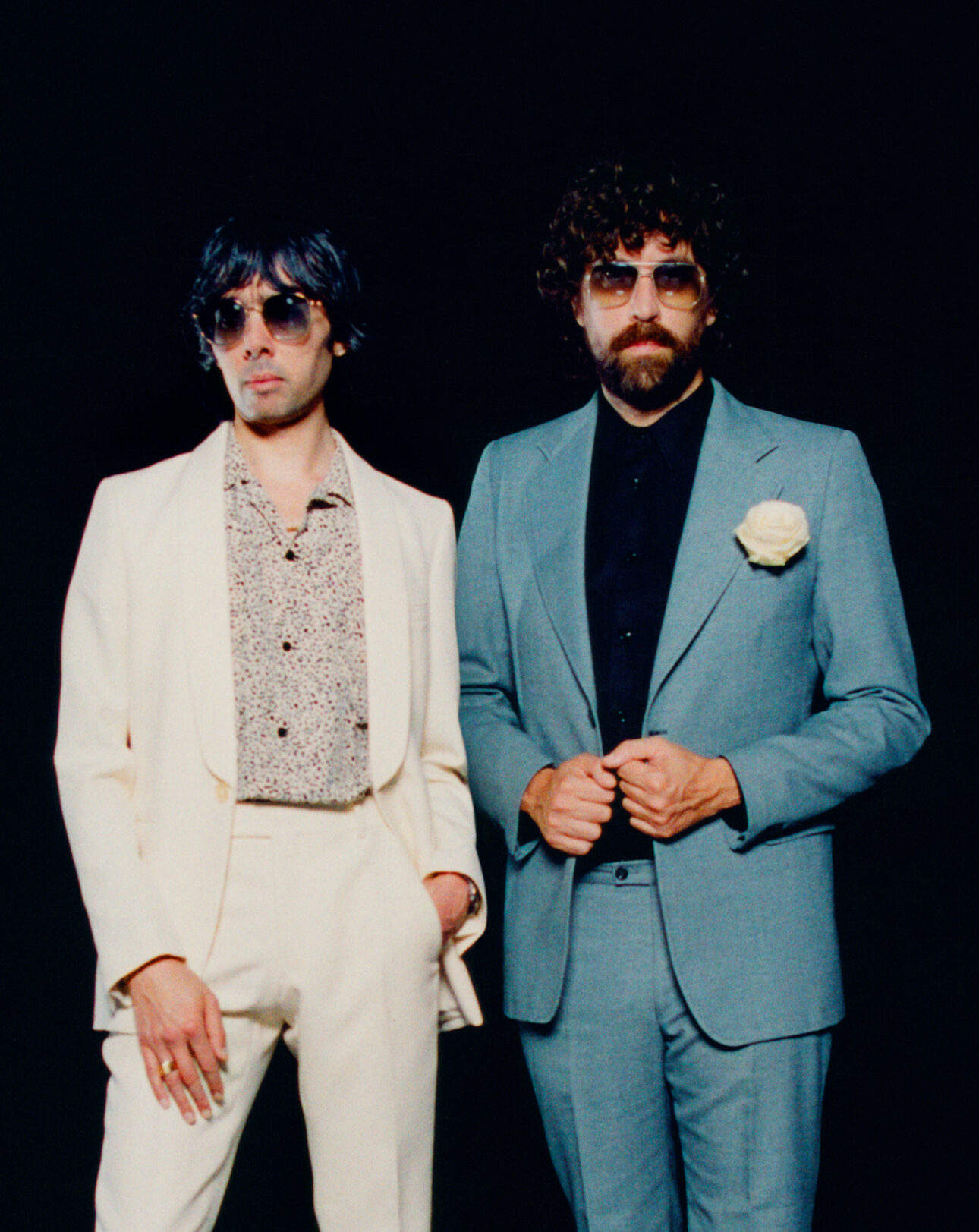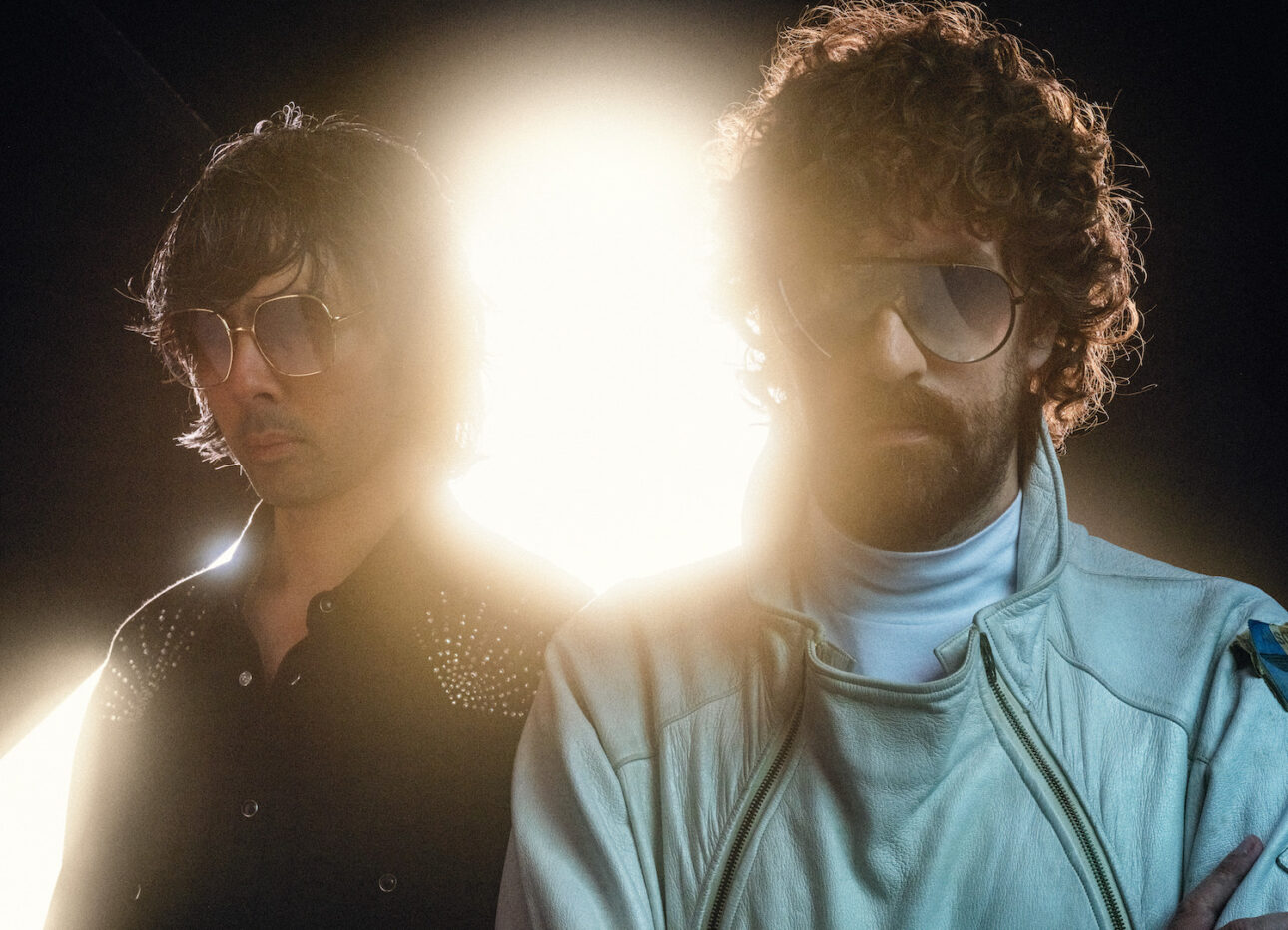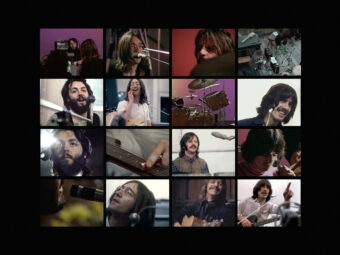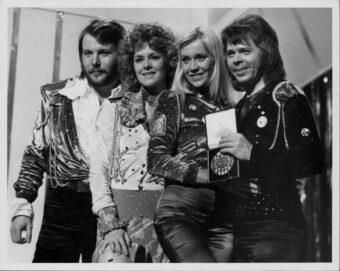With 10 minutes until Justice’s first show in six years, a swarm of devotees were camped at Coachella’s Outdoor Theater, and more were filing in. Anticipation heavied the air with super fans showing off their † tattoos (Justice’s logo) and homemade Justice tees, as well as a pre-show soundtrack of…the Doobie Brothers, 10cc, and Spandau Ballet.
Men in hard hats rushed to hang giant LED screens twice their size. “Do you see these lights?” A security hand turned to the adults, who giggled like schoolchildren, cramped against the front rail. “Wait ‘til you see. You’re going to love it.”
The show started 12 minutes late, but the French electronic duo shattered their relative silence with an audio-visual experience that felt like a glimpse into some sci-fi future. The duo’s previous album, Woman Worldwide, won a Grammy in 2019 for Best Dance/Electronic Album and set a new bar for the industry, unveiling state-of-the-art moving rigs that baffled stagehands who had to build the thing at festivals.
The production debuted at Coachella, which will now be taken on tour across the U.S. and Europe, made that set-up look primitive. It slaps the viewer with 11 face-melting tons of lighting tech, expertly timed and choreographed to match the duo’s whiplash soundtrack.
“Chaos” is an apt word to describe a Justice concert. Since the band’s 2007 live debut, their signature heavy-metal disco and pummeling theatricality have sent fans into wide-eyed frenzies. Absolute masters of dynamics, members Gaspard Augé and Xavier de Rosnay instinctively know how to turn the trauma up to 11, then wrap the audience in a blissful and elegant reprieve.
Their live show is maniacal, an overwhelming assault of the senses that has evolved into something so opulent it might tell the crowd to “Eat cake,” yet the men who stand at its center are famously unphased. They are the eye of a cultural hurricane, known to send fans into absolute fits should they do something as blase as light a cigarette.

“We’ve seen reports saying, ‘How are these guys so calm when there’s so many things happening?’” de Rosnay says the next day backstage. “The truth is we’re not calm. We’re just trying to focus.”
Nerves masked as mystery are one facet of the Justice enigma. The duo spent six months rehearsing to ensure the onslaught of reflective mirrors, moving lights, and fast-shifting rigs (hovering feet from their unprotected skulls) don’t distract from the music making.
“Actually, there’s a lot of moments where we don’t see anything on stage,” de Rosnay says. “We have very small lights a bit everywhere because we’re in pitch black most of the time.”
Their control is surgical, from the fresh blend of the band’s catalog to the position and execution of each flashing light. It’s as if the guys stuck their fingers into your brain and hacked your body’s physical and emotional response.
Perhaps that’s why the cover of Hyperdrama—Justice’s first studio album in eight years—features the group’s iconic cross stuffed with a spine, organs, and glowing nervous system.
“When we first thought about [the cover], we had this idea of a transparent man,” Augé says. “It really fits the aesthetics of the music to have this moist organic matter inside something very sleek.”
“But that’s always been part of our music,” de Rosnay adds. “It could have been the album cover for our first record. It’s really the confrontation of the dirty and the clean, the human and the perfection of the digital or the machines. It’s something that is both repulsive and attractive too, which we love.”
Duality is key to Justice and always has been. Just as the concept of justice is symbolized by shifting scales, Justice the musical act exists to explore the tension between extremes. Their chaotic shows and calm demeanor are just one dimension of the interplay. The music is, of course, the base, and that too is a juxtaposition.
The pair met playing in a band when de Rosnay was 19 and Augé 22 (“Very poorly,” Augé adds), and bonded over summers spent in Parisian pawn shops called Cash Converters buying old €1 records.
“They were very instrumental in the way we build Justice,” de Rosnay says, naming The Buggles, ‘80s new wavers Visage and electro-classical composer Saint-Preux’s ‘81 record To Be Or Not as part of that haul. “It was a very decisive moment for us.”

Justice’s debut album † (pronounced “Cross) was released in 2007 through Ed Banger Records. It was a funky barrage of musical distortion, crunching so hard on singles “Genesis,” “Phantom Pt. II” and “Waters of Nazareth,” that listeners thought their speakers were blown. Those harsh moments were balanced by the euphoric disco of “D.A.N.C.E.,” “Tthhee Ppaarrttyy” with Uffie, and others.
The album was released at the height of Daft Punk’s Alive tour, which turned that French duo into global legends and set a new industry standard for live production with their now-iconic rainbow pyramid. Comparisons between the two Parisian acts were immediate and easy to defend. At the time, Daft Punk and Justice shared a manager in Pedro Winter, aka Busy P, who founded the Ed Banger label in 2003 and signed Justice that same year.
When attendees wandered out of Daft Punk’s electrifying pyramid performance seeking similar stimulation, † welcomed them with open arms. It was a one-two punch of French Touch insanity that became a zeitgeist.
Justice sealed their rowdy reputation with a 2008 tour that leaned into rock’n’roll’s unruly roots. They performed behind a wall of Marshall amps, dressed in ripped denim vests and tight jeans, and played Metallica’s “Master of Puppets” as an encore. They turned dance floors into mosh pits, and the tour’s untamed energy was captured by a live album and documentary, each titled A Cross The Universe.
† was nominated for the Best Dance/Electronic Album Grammy, and though it lost to The Chemical Brothers, luminaries, and hit-makers from Skrillex to The Chainsmokers have all gushed about the album’s impact—yet Justice exists outside the modern dance machine.
Stand-alone release Planisphere, a classically-composed four-movement epic with a Justice twist, expanded on the band’s crunchy sound. In 2011, when EDM hit its commercial peak, the duo returned with Audio, Video, Disco. The album wears references to The Who, AC/DC, and Led Zeppelin on its sleeve, incorporating stadium rock into Justice’s metal-disco sound.
Woman, released five years later, doubled down on these influences. It was on that tour that Justice first jumped into hyperspace, building the stage that would become the sensorial behemoth currently on display.
“We don’t really give in to instant feedback,” Augé says. “We never share stuff that we’re not 100 percent sure about. When you start asking opinions and advice from too many people, it always leads to something a bit compromised.”
There’s always someone in a comment section or a critical under-narrative positing that the dirty magic of † was Justice’s peak. How many times can you lead a generational culture shift with a single album? But when Justice hit the road supporting Woman, nothing was ever the same.
Justice and their lighting designer, Vincent Lerisson (whom they consider a third member), spent months touring conventions, buying state-of-the-art gear to craft a mind-blowing stage. The Marshall amps became glowing LED screens, upstaged only by the death-defying rigs that move lightning-fast above the band’s heads. Orchestral grandeur and arena-rock posturing mixed with gritty metallic fuzz and sci-fi disco, swirling pieces of all three albums into a sum greater than its parts. The group’s 2018 live album Woman Worldwide makes the filtered noise of A Cross The Universe sound downright rudimentary.
“The best thing you can propose to people is what you are, and it comes with the bad and the good,” de Rosnay says. “The very dangerous thing with trying to please people in music, [if you] think, ‘we need to make a hit. That’s how a hit is made,’ then you have two possibilities: Either you managed to make a hit—Fine. Nothing to say about it, good or bad—but if you fail, you’re left with nothing.”
“Just shame and regret,” Augé interjects.
“So 10 years after, you look in the rearview mirror, ‘Well, it didn’t work and I don’t even like this track,’” de Rosnay continues. “At least if you make something you like at the moment, you made it. Even if it fails, this is something you can be proud of. That’s the most important because the truth is we have no control whatsoever on how people are gonna receive our music, or if people are even gonna listen to it.”
In the years that followed, the COVID pandemic hit, which halted plans to work on new tunes. Augé kept busy writing a solo record. Titled Escapades, it’s a fanciful exploration of his most cinematic influences.
“It was really a fun trip on my own,” he says, “but I’m happy to come back to the mothership.”
“We have to reset a bit and not fall asleep on what we think we know, at the end, we don’t know a lot of things,” de Rosnay says. “Even with the few things we’ve made, sometimes we are already stuck in patterns and ways of thinking. To us, freshness and spontaneity is one of the most important things.”
Jarring, ambitious, complex, and conceptual, Hyperdrama has Justice’s hallmark textures and layers but feels more sophisticated. Miguel, Tame Impala, and Thundercat appear, among others, signaling a shift for the band who so far refrained from marquee collaborations. It could be seen as a crossover play, yet the album’s 13 tracks sound anything but a concession to pop ideals.
The songs are crisp, sometimes changing from completely synthetic to totally analog instrumentation from one measure to the next. The schizophrenic “Incognito” is a good example, or the mid-song meltdown of the year 3000 lounge-funk of “Dear Alan.”
“We are very, very attracted to things that are slightly off, but at the same time perfectly executed,” de Rosnay says. “For example, ‘70s Brazilian furniture. Some sofas look like they are wearing braces or they are swollen because they were stung by a bee. They look a bit sick and uncomfortable.”
Hyperdrama is downright weird at times. On “Explorer,” Connan Mockasin leads the listener in a nightmarish guided meditation, 10 times creepier than Vincent Price on “Thriller.” And for all those fans who just want to be face-slapped with mechanical mayhem, “Generator” is as assaultive as live-set mainstays “Chorus” or “Genesis.”
“When we make an album, we always … make something that is unpleasant to hear, that can be a bit unsettling or even painful,” de Rosnay says. “‘Stress’ is a good example of that, or even ‘Muscle Memory’ or certain parts of certain songs. We want them to be a bit difficult, because—it shouldn’t be like this, but it is—pleasure is always bigger when you have to go through darker places before.”
When Justice unveiled its show at Coachella, Hyperdrama tracks “Afterimage” with Rimon, and “Mannequin Love” with the Flints had their worldwide debut on stage. Augé says the crowd reception seemed positive.
“A live show for us is meant to be celebratory,” de Rosnay says. “In times of doubt, we always think of that word of wisdom by James Murphy: ‘Shut up and play the hits.’”
From its cinematic opening to its explosive lightspeed end, the Hyperdrama tour is a blistering, breakneck rollercoaster of rapturous highs, edge-of-your-seat builds, and romantic releases—oh, and that one horror-movie moment when the lights go red and they play “Stress.”
Coachella sold commemorative t-shirts that read “I survived Justice, Live in California.” Enough said.
“We are always afraid to talk too much about what people should expect or how they should listen to the music,” Augé says. “It’s ruining all the fun, so just listen and watch.”
“Yes, forget about everything you just read,” de Rosnay adds. “Forget everything you heard, and try to go fresh, reset, and just enjoy the good surprise.”





